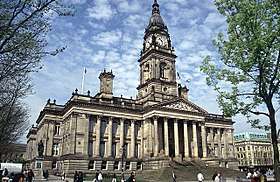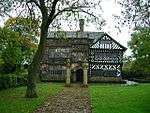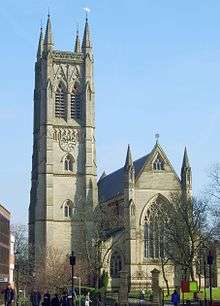Bolton School
Bolton School is an independent day school in Bolton, Greater Manchester. It comprises a co-educational nursery, co-educational infant school (ages 5–7), single sex junior schools (ages 7–11) and single sex senior schools including sixth forms (ages 11–18). With almost 2,400 pupils, it is one of the largest independent day schools in the country.[1]
| Bolton School | |
|---|---|
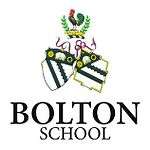 | |
| Address | |
Chorley New Road , BL1 4PA England | |
| Coordinates | 53.579868°N 2.454865°W |
| Information | |
| Type | Independent school |
| Established | ante 1516 |
| Founder | Viscount Leverhulme |
| Chair of Governors | Ian Riley |
| Headmaster (Boys' Division) | Philip Britton MBE |
| Headmistress (Girls' Division) | Sue Hincks |
| Gender | Co-educational Nursery and Infant School, boys and girls Junior schools and Senior Schools |
| Age | 3 to 18 |
| Enrolment | 2400 (approx.) |
| Houses | Wigan, Blackburn, Manchester, Chorley |
| Colour(s) | Black and white |
| Publication | The Boltonian, the Cockerel, the Bugle |
| Former pupils | Old Girls' Association and Old Boltonians' Association |
| Boys' Division Motto | Mutare Vel Timere Sperno (I scorn to change or to fear) |
| Girls' Division Motto | None |
| Website | http://www.boltonschool.org/ |
History
Early history
Established as Bolton Grammar School, it is not known exactly when the boys' school was founded although it is recorded in 1516. In 1524, William Haigh of Wigan left land worth 33s 4d towards the maintenance of a schoolmaster to teach grammar in Bolton.[2] In 1644, it was endowed by Robert Lever and so began the start of a long relationship with the Lever name. During the 17th Century, the school moved from its original Tudor building to new premises beside the Parish Church in Bolton.
Bolton Girls' Day School was established on 1 October 1877 as one of the earliest public day schools for girls in the country.[3] The schoolroom was in the Mechanics' Institute, and the first intake was 22 girls. The school was renamed Bolton High School for Girls and moved to the Park Road site in 1891. Its new building was opened by the suffragist Mrs Millicent Fawcett and the school had 67 girls on roll.
In 1899 Bolton Grammar School for Boys moved to its current location on Chorley New Road shortly after its amalgamation with Bolton High School for Boys. The move was made possible by Sir William Hesketh Lever. He had agreed to put up £5,000 and to be co-opted as a governor of the school in 1898 and a year later bought the freehold at Westbourne and offered it the school. He also financed the necessary building alternations. The school remained in these premises at Westbourne until 1932.[4]
In 1906, Bolton High School for Girls and its headmistress, Olivia Dymond, were congratulated by inspectors for "exercising a good influence on the girlhood of Bolton, not only intellectually but in other ways, not less important in the formation of their characters." School uniform and compulsory games were introduced during Miss Drymond's tenure as headmistress.[5]
The New Foundation
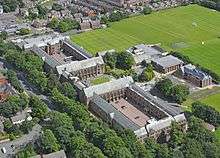
In 1913, Sir William Hesketh Lever jointly endowed the Bolton Grammar School and the Bolton High School for Girls, on condition that they should be equal partners known as Bolton School (Girls' and Boys' Divisions). On 1 April 1915, the Bolton School Foundation formally came into existence.
Construction of the Boys' Division and Girls' Division buildings began in 1924. In the same year, the school was granted a Coat of Arms. The Boys' Junior School was established at Broomfield on Chorley New Road in 1928 and in 1938, the school moved to the Park Road site where the Bolton High School for Girls had once been situated. The 1950s saw the creation of a new sports level and the building of the Tillotson Pavilion, and a grant from the Industrial Society funded the construction of a new Boys' Division chemistry block which opened in 1958. The main wings of the Boys' Division and Girls' Division were completed in 1965 realising Lord Leverhulme's plan to have purpose-built school buildings.[6]
Modern history
In 1982, the Leverhulme Pavilion at Oldfield was opened by Philip Lever, 3rd Viscount Leverhulme, Lord Leverhulme's grandson. Other additions to the school's facilities include the sports complex and swimming pool in 1986; the Arts & Conference Centre, opened by Diana, Princess of Wales in 1993; and Patterdale Hall, an outdoor pursuits centre at the southern end of Ullswater in the Lake District.
The school completed a £19m expansion project and renovation project including refurbishment and an extension to the Junior Boys' School and the construction of a new Infant School building in 2009.[7][8]
The Beech House building was then demolished to make away for a new Junior Girls' School building, Hesketh House, built in 2010.[9] After ten years planning, building work began on the £7million co-educational Riley Sixth Form Centre in the Summer of 2012[10] and the facility was ready for use in the Autumn Term 2013.[11] The Riley Centre was named after its lead benefactor Ian Riley who was a pupil from 1974 to 1981. It stands where Leverhulme envisaged a chapel and has been described as a secular and modern interpretation of the original plan uniting the Girls' and Boys' Divisions.[12] Recently it has won a swathe of awards including the Queen’s award for voluntary service and the TES Independent School of the Year award in 2019
Extracurricular activities
The school has over 100 clubs and activities for pupils to take part in at lunchtimes and after school, in addition to orchestras, choirs and sports teams.[13] The Boys' Division has a strong sporting heritage, with in-school trophies for football, cricket and gymnastics dating back 100 years.[14] The school also takes part in regional and national schools' competitions and has a good reputation at these levels.[15]
Pupils are given the opportunity to complete their Bronze, Silver and Gold Duke of Edinburgh's Award.[16] In Year 11, pupils are encouraged to take part in National Citizen Service, which feeds into the Sixth Form Community Action scheme. Both schemes encourage pupils to give their time to their local communities.[17]
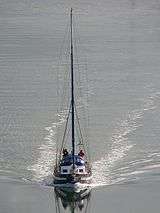
Outdoor pursuits
The school maintains an outdoor pursuits department and operates Patterdale Hall, a residential outdoor pursuits centre on the shores of Lake Ullswater in the Lake District. Pupils gain experience of the world of business and commerce through the 'Business Awareness' course held at Patterdale Hall.[18]
The Boys' Division Senior School and Boys' Junior School offer annual residential outdoor pursuits trips to Patterdale Hall to all age groups, from Year 4 to Year 13. The Girls' Division Senior School and Girls' Junior School also offer these trips to selected year groups from Year 5 and up. The team at Patterdale Hall, alongside outdoor education staff based in Bolton, assists girls and boys in achieving the expedition part of their Duke of Edinburgh's Award.
Between 1999 and 2007, Boys' Division pupils constructed a concrete yacht during Technology lessons and lunchtimes as a millennium project ("The Third Millennium Ketch"). It was launched in May 2007. Named "Tenacity of Bolton", the ketch allows Year 8 and 9 pupils the chance for sailing voyages in the Irish Sea.[19] In September 2014, the "Tenacity of Bolton" was gifted to the Tall Ships Youth Trust to be operated by the Trust, with Bolton School pupils continuing to make use to the ketch.[20]
Coat of Arms and Motto
The school coat of arms was granted to the Boys' Division in 1923.
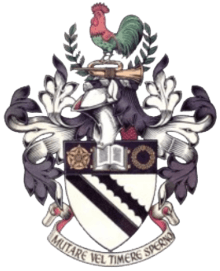
The devices of two black diagonal stripes, the edges of the upper one scalloped, on a silver shield together with the cock and bugle crest have been used by the Lever families of Great, Little and Darcy Lever since the Middle Ages. The cock and bugle are heraldic puns: the Lever name transposes to "se lever" in Norman French, the language of heraldry, which means "to arise"; the cock is the bird whose crow causes the world to arise, while the trumpet sounds "Reveille".
In order for the school to differentiate itself, additional appropriate symbols were added:
- Gold Rose of Lancaster: appears in gold rather than red to abide by the Rule of Tincture and also to make it stand out against the black background
- Open Book: frequently found in the heraldry of academic institutions to represent learning
- Gold Chaplet of Roses: again in gold to abide by the Rule of Tincture, this signifies honour and also the Hulme family.[21] Lord Leverhulme also used this charge (albeit in red) on his mayoral arms.[22]
The Girls' Division was given permission to display the same arms on a lozenge (i.e. diamond) surmounted by a true-lovers' knot. The Girls' Division does not make use of the crest. This is unusual in heraldry; although unmarried ladies' parental coats of arms would be displayed in this manner, female institutions such as convents normally utilise a shield.[23]
The school's motto is Mutare Vel Timere Sperno, meaning "I scorn to change or to fear".[24] This is used exclusively by the Boys' Division.
Former pupils
Bolton School's alumni are known as Old Girls and Old Boys. Former Boys' Division pupils are also known as Old Boltonians.
The Old Girls' and Old Boys' Association is a thriving global community. The Association organises regular reunions and events, keeps former pupils informed of current events at the school and of the successes of their peers, and often invites Old Boys and Old Girls back to the school to share their expertise and life experiences with current pupils.[25]
The school's Old Boys run and take part in three sports clubs: The Old Boltonians AFC,[26] the Old Boltonians' Golf Society,[27] and the Old Boltonians' Rugby Union Football Club.[28] Membership is open to all former pupils and staff.
For details of notable former pupils please see the List of Old Boltonians.
See also
References
- "Bolton School – Independent School for Bolton, Lancashire, Manchester". Retrieved 10 January 2010.
- "Records of early English Drama – Lancashire" (PDF). Archived from the original (PDF) on 17 September 2012. Retrieved 17 October 2010.
- Brown, W.E. (1976). The History of Bolton School. Bolton: Bolton School.
- Brown, W.E. (1976). The History of Bolton School. Bolton: Bolton School.
- Brown, W.E. (1976). The History of Bolton School. Bolton: Bolton School.
- "Bolton School: History". Retrieved 22 January 2013.
- "Pupils Enjoy New State-of-the-Art School". Archived from the original on 17 August 2011. Retrieved September 2009. Check date values in:
|accessdate=(help) - "£1.5m Refurbishment to Junior School". Archived from the original on 30 August 2012. Retrieved December 2009. Check date values in:
|accessdate=(help) - "Junior Girls Enjoy their New School". Archived from the original on 6 October 2012. Retrieved September 2010. Check date values in:
|accessdate=(help) - "Sixth Form Students Start Building a New Centre". Retrieved 29 January 2014.
- "Autumn Opening for Multi-million Pound Sixth Form Centre". Retrieved 29 January 2014.
- "RIBA Journel: Buildings – School – The Riley Centre, Bolton School". Archived from the original on 21 February 2014. Retrieved 23 January 2014.
- "Clubs and Extra-Curricular Activities". Retrieved 6 February 2014.
- "A Decade of Centenaries". Archived from the original on 24 March 2014. Retrieved 30 January 2014.
- "Bolton School Sports Overview". Retrieved 6 February 2014.
- "Patterdale Hall Residential and Adventure Learning Centre and Tenacity of Bolton". Retrieved 29 January 2014.
- "Bolton School Sixth Form Community Involvement". Retrieved 6 February 2014.
- "Patterdale Hall and Tenacity of Bolton". Retrieved 19 February 2014.
- "Patterdale Hall Residential and Adventure Learning Centre and Tenacity of Bolton". Retrieved 29 January 2014.
- "TENACITY OF BOLTON JOINS THE TALL SHIPS YOUTH TRUST FLEET". tallships.org. Archived from the original on 21 April 2017. Retrieved 20 April 2017.
- Brown, W.E. (1976). The History of Bolton School. Bolton: Bolton School.
- "The Mayors of Bolton: Lord Leverhulme (William Hesketh Lever)". Retrieved 23 January 2014.
- Brown, W.E. (1976). The History of Bolton School. Bolton: Bolton School.
- The History of Bolton School W E Brown MA, Bolton School 1976, ISBN 0-9504947-0-4 with an extended essay by F R Poskitt, CBE MA
- "Old Boys and Old Girls". Archived from the original on 23 February 2014. Retrieved 30 January 2014.
- "Old Boltonians' AFC". Retrieved 29 January 2014.
- "Old Boltonians' Gold Society". Retrieved 30 January 2014.
- "Old Boltonians' Rugby Club". Retrieved 30 January 2014.
External links
- Bolton School website

